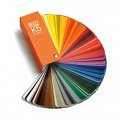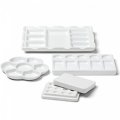Mixed pallets
Information about mixing pallets
There are many different kinds of palettes for efficiently mixing paints, be they for a painter standing in front of an easel or sitting at a table or for painters using watery or pasty paints. The different version include ones with mixing wells (depressions), ones with or without thumb holes or ones made of wood, plastic or porcelain. Ideally, the palette should be the same colour as the substrate to be painted on (called the “support” in artist’s circles) so that the painter will have a more realistic idea of how his mixed paint will look when applied to the actual picture.
When painting at an easel, the palette is usually held in one’s hand. Lightweight plastic or wooden palettes with a thumb hole are particularly useful in this instance whereby the painter inserts his thumb into the thumb hole from underneath, places the palette securely on his hand and rests the rear portion on his forearm. Heavier porcelain palettes and ones without thumb holes are more suitable for work being done at a table.
The choice of whether to use a palette with deep mixing wells or one with a completely flat surface depends on the consistency of the paint to be used for a particular job. For pasty paints like oil or acrylics, the best choice is a palette with a large, flat surface whereby the paints can be directly squeezed from the tube onto its outer edge in order to leave the middle area available for mixing them. Any remaining paint on such a flat surface can be easily wiped off (when wet), or stripped off (in the case of dried acrylic paints from certain types of plastic), or scraped off (when dry) with a palette knife. Palettes with deep mixing wells are recommended for work with watery paints like watercolours, gouache or with acrylic and oil paints thinned with painting auxiliaries (for glazing purposes) because the wells will prevent any unwanted mixing in of adjacent paints.
Plastic palettes can be used for paints that can be worked with without the need of solvents - for example, watercolours, gouache and acrylic paints. For fast-drying acrylic paints there are palettes made of a type of plastic from which a dried coat can be easily pulled off. Please note: in the case of oil painting, during which paint media and cleaning agents that contain solvents are often used, there is the danger that said solvents could corrode a plastic palette.
Wooden palettes are especially good for use with oil paints as long as the surface is treated with an agent that will prevent it from extracting the oil content of the paint through absorption. Any remaining wet oil paint can be removed from a flat wooden palette by simply wiping it away with turpentine oil or white spirit – dried paint can be scraped away with a palette knife. A metal palette “pan” that can be attached to your palette is another possible tool for working with watery (oil) painting mediums.
Palettes or small bowls made of porcelain are very versatile because they are resistant to solvents, acids and bases. Their glazed surface will not yellow, is easy to clean and helps keep your paint moist for a longer period of time.
Although they make less sense ecologically, tear-away palette sheets of siliconized paper are nonetheless a very practical solution for painting with oils and acrylics. After your painting work is completed, the top sheet is simply torn off and thrown away with any remaining paints still on it. This method has proven to be excellent when working with fast-drying acrylic paints and when a painter wants to mix his oils on a white substrate.





